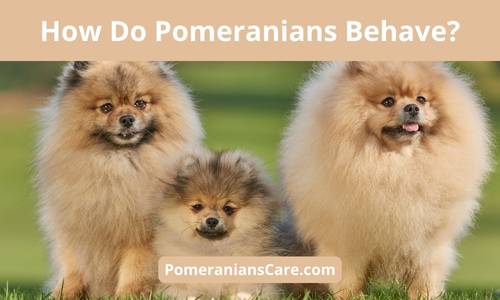Pomeranians are undeniably adorable. But, like all breeds, they come with their quirks and behavioral challenges. In this comprehensive listicle, we’ll go deep into “What are the behavioral issues of Pomeranians,” offering insights and understanding for every Pom parent out there.
1. Excessive Barking
Why Do Pomeranians Bark Excessively?
- Bred for Alertness: Historically, Pomeranians were bred as watchdogs. Their primary function was to alert their owners to any potential threats or changes in the environment. This instinct remains strong in many Poms today, making them quick to sound the alarm, even for minor disturbances.
- High Energy Levels: Pomeranians are known for their vivacity and enthusiasm. If they aren’t provided with adequate mental and physical stimulation, they might resort to barking as an outlet for their pent-up energy.
- Separation Anxiety: Some Pomeranians become particularly attached to their owners and can experience separation anxiety when left alone. This anxiety can manifest as persistent barking.
- Attention Seeking: Pomeranians, with their endearing personalities, often love being the center of attention. Barking can sometimes be their way of demanding interaction or playtime.
- Environmental Triggers: Common triggers like doorbells, other animals, or even passing cars can prompt a Pomeranian to bark. They are keen observers and respond vocally to many stimuli in their environment.
Tips to Manage Excessive Barking in Pomeranians

- Training: Teaching commands like “quiet” or “enough” can help control excessive barking. Always use positive reinforcement, rewarding your Pom when they obey.
- Provide Adequate Exercise: Regular physical activity can help burn off excess energy, reducing the likelihood of attention-seeking barks.
- Mental Stimulation: Puzzle toys, training sessions, or even hide-and-seek games can keep a Pomeranian’s active mind engaged, reducing boredom-induced barking.
- Establish a Routine: Dogs often feel comforted by routine. Keeping consistent feeding, bathroom breaks, and playtime can provide a sense of security, reducing anxiety-induced barking.
- Desensitization: If specific triggers, like doorbells or cars, cause your Pom to bark, gradually desensitize them. This can be done by exposing them to the trigger at a low intensity and rewarding their calm behavior, gradually increasing the intensity as they become accustomed.
- Consult a Professional: If the barking is persistent and disruptive, consider consulting a dog behaviorist or trainer who can provide tailored strategies.
2. Dominance and the Napoleon Complex
The Napoleon Complex, often associated with humans, especially those of shorter stature demonstrating aggressive or dominant behavior, has been humorously extended to describe certain canine behaviors as well. Pomeranians, despite their petite size, often exhibit traits that can be likened to this complex. But what exactly is the Napoleon Complex when it comes to Pomeranians, and how does it manifest?

Origins of the Name
The term “Napoleon Complex” is derived from Napoleon Bonaparte, the French military leader. Although historical records suggest Napoleon was of average height for his time, popular culture has perpetuated the idea that he was notably short, leading to the coining of this term. The complex describes the compensation theory where an individual might display aggressive or dominant behaviors to make up for their perceived shortcomings.
Pomeranians and Dominance
Despite being one of the smaller dog breeds, Pomeranians are known for their confident, sometimes even bossy, demeanor. This juxtaposition of a small dog with a big personality can be surprising to many.
- Displaying Dominance: It’s not uncommon for a Pomeranian to try and assert dominance over larger dogs, toys, or even humans. This might manifest as resource guarding, being territorial, or even trying to “lead the pack” during walks.
- Vocal Assertion: Along with physical dominance, Pomeranians are often quite vocal. They’re quick to alert their human companions about perceived threats, sometimes even if that “threat” is just the mail carrier or a squirrel.
Reasons Behind the Behavior
Understanding why Pomeranians might display such behavior is key to managing it.
- Historical Roles: Pomeranians were initially bred to be companion dogs for nobility but also had roles as watchdogs. This watchdog instinct can explain their alertness and assertiveness.
- Natural Confidence: Some Pomeranians naturally have a confident disposition. This confidence, when unchecked, can sometimes come off as dominance.
- Lack of Socialization: Like all dogs, if Pomeranians aren’t adequately socialized from a young age, they might not learn appropriate behaviors around other dogs or people. This lack of social cues might lead to them being more assertive.
Managing the Napoleon Complex in Pomeranians
While the assertive behavior can sometimes be endearing, it’s essential to ensure it doesn’t lead to problematic aggression.
- Early Socialization: Exposing your Pomeranian to various experiences, people, and other pets at a young age can help them learn appropriate behaviors.
- Training: Positive reinforcement training can help establish boundaries and teach your Pom what behaviors are acceptable.
- Stay Calm and Assertive: Dogs often mirror their owner’s energy. Staying calm and assertive can help your Pomeranian feel secure, reducing the need for them to take charge.
3. Over-Attachment and Separation Anxiety

Why Do Pomeranians Experience Over-Attachment and Separation Anxiety?
- Bred for Companionship: Pomeranians were historically bred to be companion dogs, always by their owner’s side. This historical role has ingrained a deep sense of loyalty and attachment in the breed.
- Small Size & Vulnerability: Due to their petite stature, Pomeranians might feel more vulnerable and dependent on their owners for safety and comfort.
- Sensitive Temperament: Pomeranians are highly perceptive and can pick up on their owner’s emotions and routines. Any change can make them anxious.
- Past Traumas: Like all dogs, Pomeranians with a history of abandonment or frequent changes in ownership might be more prone to develop separation anxiety.
Signs of Over-Attachment and Separation Anxiety in Pomeranians
- Following You Everywhere: Often referred to as the ‘shadow syndrome,’ an over-attached Pomeranian might follow you from room to room, rarely letting you out of their sight.
- Distress When You Leave: Even if it’s for a short while, they might exhibit behaviors like excessive whining, barking, or pacing.
- Destructive Behaviors: In more severe cases of separation anxiety, Pomeranians might resort to chewing furniture, digging, or attempting to escape in their owner’s absence.
- Physical Symptoms: Continuous crying, drooling, or even inappropriate elimination might be signs of distress in an anxious Pomeranian.
Managing Over-Attachment and Separation Anxiety
- Gradual Desensitization: If your Pomeranian gets anxious at the sight of you picking up keys or wearing shoes, repeat these actions multiple times without actually leaving. Over time, this can reduce the association of these actions with your departure.
- Safe Space: Create a designated area for your Pom, filled with their favorite toys and comfort items. This can be a safe haven for them in your absence.
- Avoid Overly Emotional Goodbyes: While it’s tough, avoid long, emotional goodbyes. Keeping departures and arrivals low-key can reduce anxiety triggers.
- Provide Distractions: Engaging toys or treat-dispensing puzzles can keep your Pomeranian occupied when you’re not around.
- Establish a Routine: Consistent feeding, playtime, and bathroom breaks can provide a sense of security to your Pomeranian, reducing anxiety.
- Professional Help: If the anxiety is severe, consider seeking the help of a dog behaviorist or veterinarian. In extreme cases, medication might be recommended.

4. High Energy Levels and Destructive Behavior
- Energetic Furballs: Pomeranians are bundles of energy. If not channeled properly, this can lead to destructive behaviors.
- Typical Behaviors: Unchecked energy might result in actions like chewing furniture or digging in gardens.
- Channeling Their Energy: Regular play sessions, walks, and engaging toys can help burn off that excess energy.
5. Health-Related Behavioral Changes
- Physical Issues and Behavior: Sometimes, a change in behavior can indicate underlying health issues.
- Common Pomeranian Health Concerns: Dental issues, Luxating Patella, or hypoglycemia can affect their behavior. For instance, a usually playful Pom becoming aggressive might be in pain.
- Solution: Regular vet check-ups and being observant of any sudden behavioral changes can help address and manage health-related behavioral issues.
6. Assertiveness and Training Challenges
- Intelligent but Stubborn: Pomeranians are smart, but they can also be quite stubborn, which can pose challenges during training sessions.
- The Training Challenge: Their assertiveness can sometimes be mistaken for disobedience.
- Overcoming the Challenge: Consistent, positive reinforcement-based training is the key. Keeping sessions short but regular can yield better results.
Joyful Nature of Poms
Pomeranians are playful creatures with a knack for finding joy in everything. Their intelligence and zest for life mean they’re constantly looking for fun activities. They especially love games, puzzles, and toys that challenge their minds.
Close Companions
While they can be a bit independent, Pomeranians are very much people-dogs. They often act like little shadows, sticking close to their human family members. However, this strong bond can sometimes lead to over-attachment and separation anxiety, a behavioral issue we’ll discuss more in-depth later.
Understanding Pomeranian Behavior
Yes, Pomeranians are known for their cute looks, but they can sometimes display challenging behaviors. As a potential Pomeranian owner, understanding what are the behavioral issues of Pomeranians can help strengthen your bond with your pet. After all, every dog breed has its quirks. Now you know what are the behavioral issues of Pomeranians. Keep reading Pomeranians Care to find out more!





 No products in the cart.
No products in the cart.